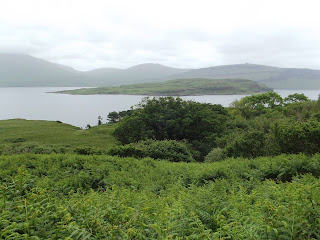My Place: Eorsa – a small rock off the isle of Mull
Today, I’m reviving my popular My Place series of posts, where I invite fellow authors of historical fiction / romance / mystery to share a little about the setting of their novels. This can be a place, a town, a fictional village, or a castle.
I’m kicking off with a beautiful place in Scotland. Imagine a tiny outcrop off the Scottish isle of Mull in the Inner Hebrides. Facing westward, the small island of Eorsa is the location of my current work in progress, a Scottish medieval romance, as yet untitled. Set in the aftermath of the battle at Falkirk in 1298, it tells the tale of Isobel de Moray, whose father was killed when he helped fellow knight Cailean MacDubhgaill escape.
Following her father’s death, Isobel is abducted from her manor on the shores of Loch Ness by Scottish henchmen to marry her off to an English lord, her being a cousin of the late guardian, Andrew de Moray. During their journey along the great glen, she is freed by Cailean, and taken to his family keep on Eorsa. One could say she is abducted twice, the poor lass! :o
With Scotland in turmoil, Isobel is trying to gain the support of her father’s old friends, and of her family ties to the Comyn family which supports King John (Balliol). But Cailean is not sure about John’s future as king, and, once recovered from injuries sustained at Falkirk, continues his covert warfare against English spies. In his view, Eorsa is the safest place for an heiress such as Isobel... Entirely unselfish, of course! ;-)
I have chosen the rocky outcrop situated in Loch na Keal off the west coast of Mull intentionally, to capture the sense of remoteness, of abandonment Isobel feels. I have sadly not had a chance to visit Mull, despite having lived in Scotland for over 16 years, but I’ve often felt that edge of the world feeling you get when in remote parts of the country. It brings with it a desolation, being away from everything that (apparently) matters, of hard work to make a living, away from civilisation. But it also provides you with a sense of calm, of peace, of being one with the earth. Of purpose.
I hope to convey an idea of all that in Isobel’s thoughts and actions as I continue to write her story.
I’ve based the MacDubhgaill keep on Eorsa on other two/three-storey castles in remote Scottish locations, such as Castle Stalker, or Aros Castle on Mull. A sturdy square building with a side wing, and a walled-in yard, it would have the kitchens in an annex to keep any threat of fires from the private quarters. A cellar on the ground floor, outdoor steps would lead up to the hall, and from inside up a wooden staircase to another floor where we find the private rooms, and one floor up to a spare room under the roof. (Note to self: draw an image of the layout, or else you forget!)
Apart from a freshwater well, supplies had to be brought in by boat from Mull, and the cooks would keep salted meats and fish in the larder for winter. Ale and grain would also be brought across.
Like many Scottish islands, Eorsa may have served an ecclesiastical settlement, belonging once to the abbey at Iona, and it was used by the British Navy in WWI.
Yvonne Marjot, writer of the bestselling Calgary Chessman series of books and a resident of Mull, has kindly sent me photographs she took of Eorsa, for which I’m very grateful. They help give me a sense of location.
I hope you enjoyed my little story about Eorsa, and of Isobel and Cailean. Next week on My Place, I’ll be welcoming Scottish writer Nancy Jardine, whose Celtic Fervour series I can highly recommend to readers interested in ancient Scottish historical fiction.
Until then...
I’m kicking off with a beautiful place in Scotland. Imagine a tiny outcrop off the Scottish isle of Mull in the Inner Hebrides. Facing westward, the small island of Eorsa is the location of my current work in progress, a Scottish medieval romance, as yet untitled. Set in the aftermath of the battle at Falkirk in 1298, it tells the tale of Isobel de Moray, whose father was killed when he helped fellow knight Cailean MacDubhgaill escape.
 |
| Eorsa – (c) Yvonne Marjot |
With Scotland in turmoil, Isobel is trying to gain the support of her father’s old friends, and of her family ties to the Comyn family which supports King John (Balliol). But Cailean is not sure about John’s future as king, and, once recovered from injuries sustained at Falkirk, continues his covert warfare against English spies. In his view, Eorsa is the safest place for an heiress such as Isobel... Entirely unselfish, of course! ;-)
 |
| Eorsa – (c) Yvonne Marjot |
I hope to convey an idea of all that in Isobel’s thoughts and actions as I continue to write her story.
 |
| Eorsa – (c) Yvonne Marjot |
 |
| Castle Stalker - (c) Cathie Dunn |
Like many Scottish islands, Eorsa may have served an ecclesiastical settlement, belonging once to the abbey at Iona, and it was used by the British Navy in WWI.
Yvonne Marjot, writer of the bestselling Calgary Chessman series of books and a resident of Mull, has kindly sent me photographs she took of Eorsa, for which I’m very grateful. They help give me a sense of location.
I hope you enjoyed my little story about Eorsa, and of Isobel and Cailean. Next week on My Place, I’ll be welcoming Scottish writer Nancy Jardine, whose Celtic Fervour series I can highly recommend to readers interested in ancient Scottish historical fiction.
Until then...


.jpg)
Comments
Post a Comment